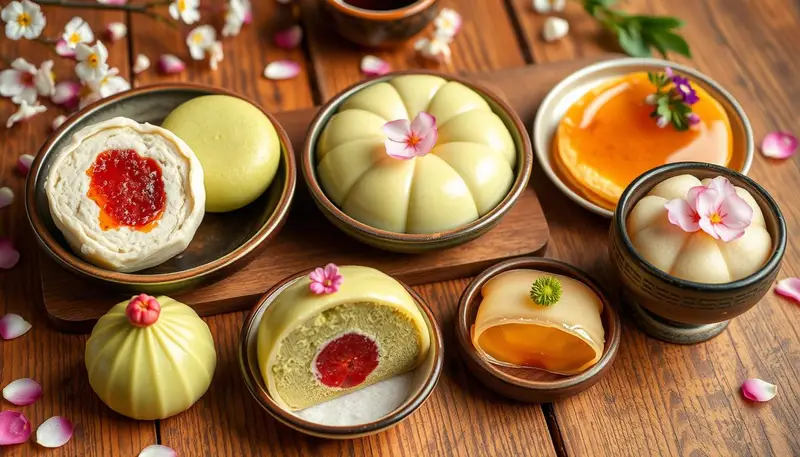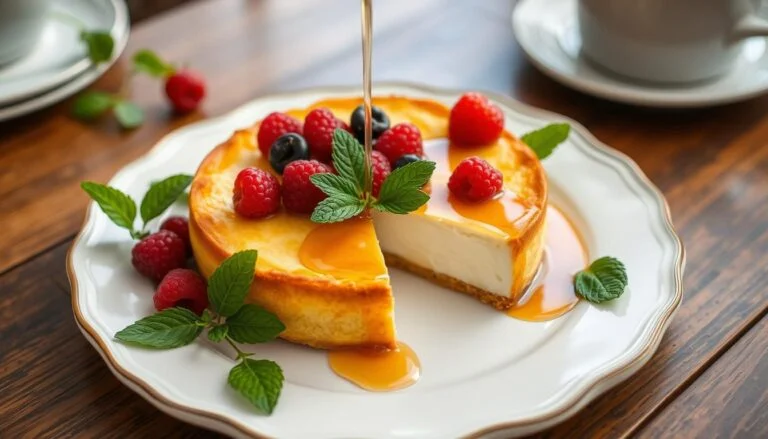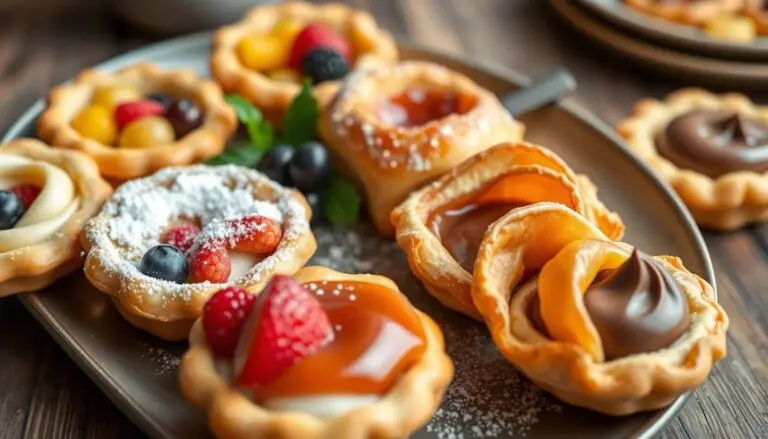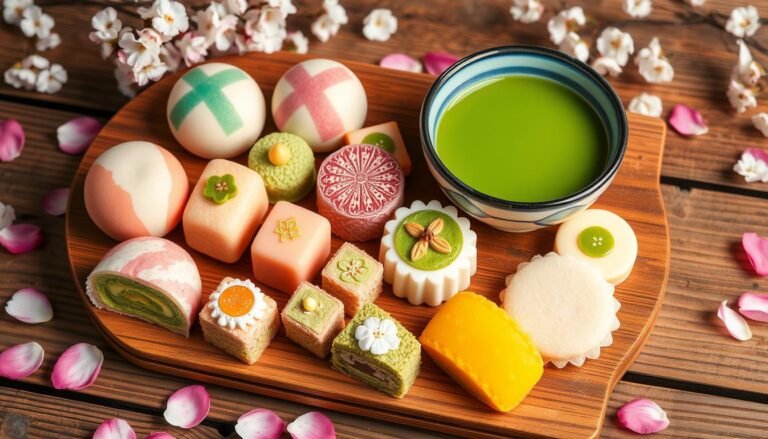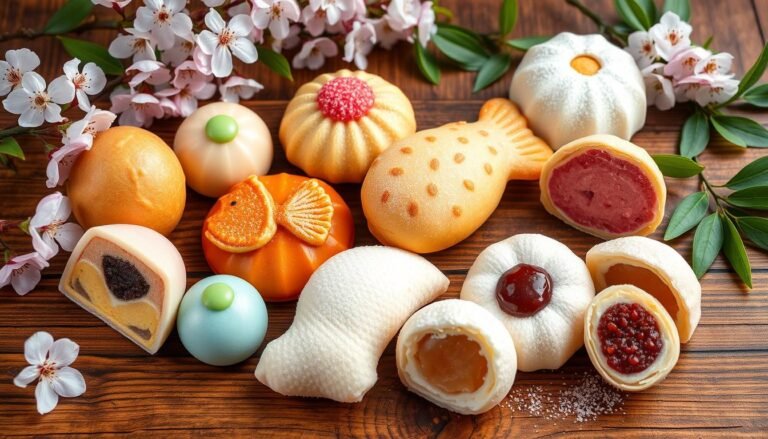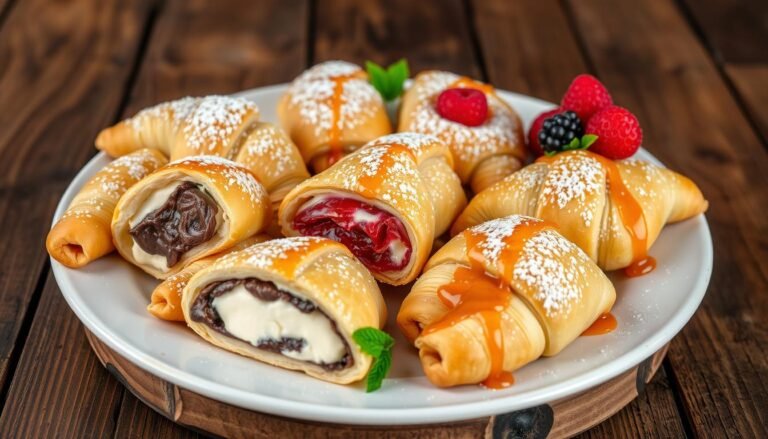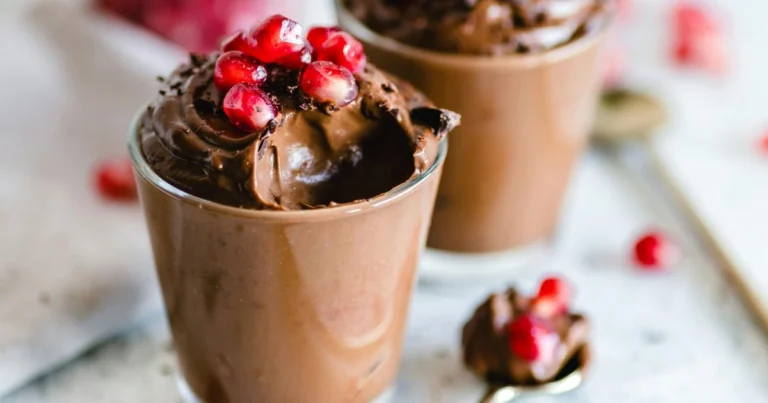Discover the Best Japanese Desserts: A Sweet Culinary Adventure
As I walked through Tokyo’s busy streets, the smell of fresh pastries and the bright colors of sweets caught my eye. The best Japanese desserts are a big part of the country’s rich food culture. They take you on a journey of taste and sight, from the delicate wagashi to the new desserts that mix old and new.
Japan’s love for sweets is huge, even though it’s smaller than China. This shows how much the country values making desserts. This journey shows you the wide range of tastes, special ingredients, and cultural importance of Japanese sweets.
Melt 10 Pounds of Fat in a Week with This Green Smoothie>> Discover Now!
Table of Contents
Understanding Traditional Japanese Sweets: The Art of Wagashi
Wagashi, the traditional Japanese sweets, have a long history. They started as religious offerings and became popular in the 14th and 15th century tea ceremonies. Made with anko (sweet red bean paste), shiroan (white bean paste), sugar, and rice flour, they show Japan’s culinary heritage.
History and Cultural Significance
Wagashi have a history of over two millennia. They mixed Chinese confectionery with Japanese sweets like mochi and azuki beans from the 6th century. In the Edo period, they varied by region, with Kyoto known for elaborate sweets and Tokyo for simpler ones. The Meiji era brought Western influences, creating modern styles that mix tradition and innovation.
Key Ingredients in Wagashi Making
- Anko (sweet red bean paste)
- Shiroan (white bean paste)
- Sugar
- Rice flour
Traditional Preparation Methods
Making wagashi is an art form, focusing on taste and looks. Special tools like nerikiri kobo, koshi-an kobo, and kashigata are used for designs. Wagashi embody simplicity, balance, and harmony, making them perfect with matcha tea.
| Types of Wagashi | Description |
|---|---|
| Namagashi | Delicate, fresh sweets made with rice flour, sweet bean paste, and agar, known for intricate designs and seasonal themes. |
| Daifuku | Soft and chewy mochi filled with sweet bean paste, often enjoyed for special occasions. |
| Mitarashi Dango | Skewered rice dumplings coated in a sweet soy sauce glaze, a popular street food. |
Wagashi are key in seasonal festivals, with shapes and colors matching each celebration. From sakura mochi in spring to kuzu manju in summer, they are a big part of Japan’s culture. They offer a mix of taste and tradition.
Seasonal Japanese Desserts Through the Year
Japan’s desserts show off its rich culinary heritage. Each dessert reflects the unique flavors and beauty of the seasons. From sakura mochi in spring to oshiruko in winter, these treats take you on a delightful journey.
In spring, sakura mochi appears. These pink rice cakes are filled with sweet red bean paste. They are wrapped in pickled cherry blossom leaves, capturing the beauty of the sakura blossoms. Summer brings mizu yokan, a chilled red bean jelly that cools you down.
Autumn highlights the versatility of seasonal ingredients. You’ll find mushi-yokan (chestnut with sweet red bean paste) and imo-yokan (sweet potato) on dessert tables. Winter warms you up with oshiruko, a red bean soup served with toasted mochi.
These desserts not only taste great but also show Japan’s love for nature. From spring’s soft flavors to winter’s comforting tastes, each dessert is a masterpiece. It shows Japan’s culinary artistry and cultural traditions.
| Season | Seasonal Japanese Desserts |
|---|---|
| Spring | Sakura mochi, sakura soft-serve, ume daifuku |
| Summer | Mizu yokan, chocomint pocky, lemon-flavored kakigori |
| Autumn | Mushi-yokan, imo-yokan, mont blanc cakes, kuri dango, chestnut roll cakes |
| Winter | Oshiruko, sake manju, strawberry parfaits, Japanese Christmas cakes |
Making these desserts is a way to appreciate nature’s changes. Each treat offers a unique experience. It shows the perfect balance of flavors and textures that people love worldwide.
The Sweet World of Japanese Desserts
Explore the world of Japanese desserts, from tasty street food to fancy tea ceremony sweets. Japan’s rich food culture has created a wide range of sweet treats.
Popular Street Food Sweets
Try the classic taiyaki, a fish-shaped cake filled with sweet bean paste or custard. Another hit is dango, chewy rice dumplings on skewers with various toppings.
Tea Ceremony Delicacies
Enjoy the beauty of namagashi, special Japanese sweets made for matcha tea. These sweets are shaped like natural things, showing Japanese confectionery’s artistry.
Festival Favorites
Discover Japanese festival sweets, where local treats shine. From fluffy dango in autumn to colorful sakura mochi in spring, these sweets show Japan’s changing seasons and traditions.
| Seasonal Japanese Desserts | Description |
|---|---|
| Spring | Hishimochi, Higashi, Sakura Mochi |
| Summer | Warabi Mochi, Kuzu Mochi |
| Autumn | Kashiwa Mochi, Tsukimi Dango |
| Winter | Nerikiri, Kusamochi |
Dive into Japan’s sweet world, where tradition, art, and seasonal flavors come together to please your senses.
Essential Ingredients in Japanese Confectionery
Japanese sweets, known as wagashi, are famous for their complex tastes and soft textures. A few key ingredients make these treats special. Let’s look at what makes wagashi so appealing.
Anko, or sweet red bean paste, is a main ingredient. It’s made from azuki beans. Anko gives a rich, sweet flavor and a smooth texture to many sweets, like mochi and yokan.
Matcha, the green tea powder, is also key. It adds a deep, earthy taste and bright color to desserts. You can find it in matcha-flavored mochi and cheesecake.
Mochigome, or glutinous rice, is crucial for mochi and daifuku. Its sticky texture makes mochi unique.
Yuzu, a Japanese citrus, brings a refreshing flavor to sweets. The sweet taste of sweet potato and the delicate scent of sakura (cherry blossoms) also play big roles in wagashi.
These ingredients, each with its own special taste, come together. They create the perfect mix of flavors and textures in Japanese sweets.
| Ingredient | Contribution to Wagashi |
|---|---|
| Anko (Sweet Red Bean Paste) | Provides a rich, subtly sweet flavor and creamy texture |
| Matcha (Green Tea Powder) | Imparts an earthy, umami-rich taste and vibrant color |
| Mochigome (Glutinous Rice) | Lends the signature sticky, chewy texture to mochi and daifuku |
| Yuzu (Japanese Citrus Fruit) | Adds a refreshing, aromatic touch to sweets |
| Sakura (Cherry Blossoms) | Contributes delicate floral notes to wagashi |
| Sweet Potato | Provides a comforting, sweet flavor to desserts |
These essential ingredients, each with its own unique character, come together. They create the harmonious flavors and textures that define Japanese sweets, or wagashi.
Modern Interpretations of Classic Japanese Sweets
In the world of Japanese desserts, a mix of old and new is exciting everyone. Matcha, a green tea powder, is now in Western sweets like tiramisu. This mix of Japanese and Italian tastes is amazing. Mochi, a chewy rice treat, is now ice cream. It’s fun and different, loved by people all over.
In Japan, cafes are full of new ideas in desserts. Chefs are making Japanese cheesecake in new ways. It’s light and fluffy, loved by many. Parfaits with colorful fruits and creams are also big hits. They look great and taste even better.
Fusion Dessert Trends
Japanese flavors mixed with Western sweets are creating new treats. Matcha tiramisu and mochi-wrapped cheesecake are just a few examples. They mix the best of both worlds, exciting dessert lovers everywhere.
Contemporary Cafe Culture
Japan’s cafe scene is now all about sweet treats. Parfaits with lots of layers are Instagram favorites. Dessert-only menus offer a special and detailed dining experience.
Instagram-Worthy Creations
Social media has made people want desserts that look as good as they taste. Mochi donuts and intricate parfaits are big hits. They inspire food lovers with their beauty and taste.
Regional Sweet Specialties Across Japan
Japan is a treasure trove of sweet treats, each with its own unique flavors and traditions. From Hokkaido’s dairy delights to Kyoto’s wagashi and Kobe’s sweets, exploring Japan’s desserts is a treat for the senses.
Hokkaido, Japan’s northernmost island, is famous for its dairy products. You’ll find luscious desserts like Shiroi Koibito cookies and rich cheesecakes. In Kyoto, the cultural heart of Japan, wagashi art shines. Delicate confections like yatsuhashi, thin crepes filled with sweet bean paste, are a must-try.
The city of Kobe is known for its diverse sweets and desserts. From Hon-Takasogoya, founded in 1867, to modern patisseries, Kobe offers something for everyone. Other regions, like Naruto, have their own unique sweets, like Naruto Kintoki sweet potato paste, available only in autumn.
| Region | Specialty Dessert | Key Ingredients |
|---|---|---|
| Hokkaido | Shiroi Koibito cookies, Cheesecakes | Dairy products |
| Kyoto | Yatsuhashi (folded crepes with bean paste) | Sweet bean paste |
| Kobe | Variety of sweets and desserts, Hon-Takasogoya | Diverse ingredients |
| Naruto | Naruto Kintoki sweet potato paste | Sweet potatoes |
From Hokkaido’s dairy delights to Kyoto’s wagashi and Kobe’s sweets, Japan’s desserts offer a delicious journey. They showcase the country’s rich culture and diverse flavors.
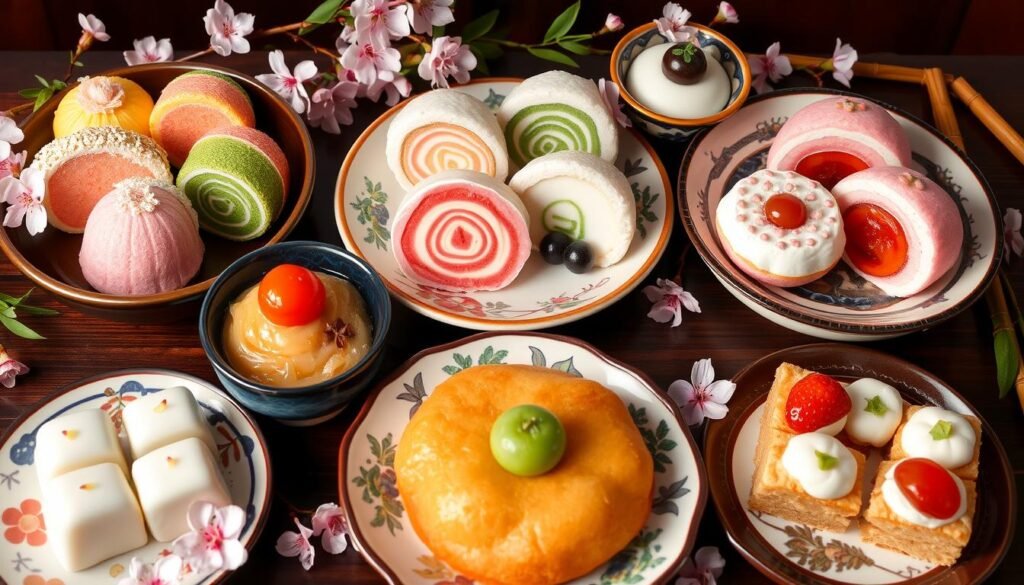
Melt 10 Pounds of Fat in a Week with This Green Smoothie>> Discover Now!
The Art of Mochi and Red Bean Treats
Explore the world of Japanese mochi and red bean desserts. Here, tradition meets innovation, creating a unique culinary experience. From tsubuan (whole bean) to koshian (red bean paste), these ingredients are key to many beloved sweets.
Types of Anko (Red Bean Paste)
Anko, the sweet red bean paste, has many forms:
- Tsubuan – Whole bean paste with a heartier texture
- Koshian – Smooth and velvety paste
- Ogura-an – A mix of whole and smooth bean pastes
- Tsubushian – Mashed beans for a creamier feel
- Sarashian – Dried beans for a unique taste
Each type of paste adds its own special touch to mochi desserts.
Mochi Variations
Mochi, the chewy rice cakes, are the base for many desserts:
- Daifuku – Mochi filled with sweet fillings like tsubuan or koshian
- Sakuramochi – Mochi wrapped in a salted cherry blossom leaf, with a floral essence
- Dorayaki – Fluffy patties with a layer of rich anko
The taste and texture of these treats depend on the anko used and how the mochi is made.
“Mochi is not just a dessert, but a cultural icon that represents the harmony between tradition and innovation in Japanese cuisine.”
Whether you try the classic tsubuan or modern mochi, these red bean treats offer a tasty journey through Japanese culinary heritage.
Japanese Tea-Infused Desserts
Japan’s tea culture has greatly influenced its desserts. Matcha and hojicha, with their unique flavors, are used in many sweets. Matcha desserts, like ice cream and green tea cookies, are loved worldwide for their earthy taste. Hojicha, with its caramel-like flavor, adds warmth to desserts.
Japanese tea desserts show the tea’s versatility. Matcha desserts are refreshing and sophisticated. Hojicha sweets offer a comforting taste. These desserts celebrate Japan’s culinary heritage.
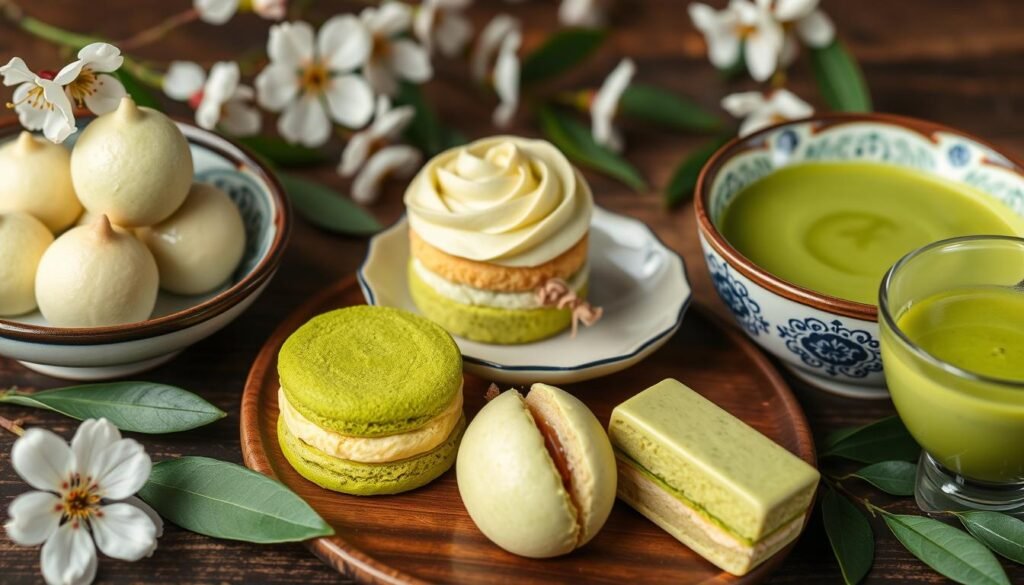
Other Japanese teas also inspire desserts. Green tea’s delicate taste is great in green tea cookies and pastries. Japan’s tea-infused desserts showcase its tea culture’s depth and complexity.
“The fusion of tea and sweets is a true celebration of Japanese culinary artistry.”
Enjoying matcha ice cream or hojicha pastries is a special treat. These desserts take you on a journey through Japan’s rich food traditions.
Must-Try Japanese Dessert Cafes and Shops
Japan’s dessert scene is full of sweet surprises. You’ll find traditional wagashi shops and trendy cafes with Instagram-worthy treats. Whether in Tokyo or other cities, these spots are a must-visit for dessert lovers.
Tokyo’s Sweet Spots
In Tokyo’s heart, Harajuku is famous for its chic dessert cafes. Maison Able Cafe Ron Ron is a highlight, offering an all-you-can-eat buffet for 40 minutes. Prices start at 2,100 yen for females and 2,400 yen for males. You can try everything from chocolate cakes to traditional Japanese sweets like dango and mochi.
For a traditional taste, visit Asakusa’s historic wagashi shops. Kame Juu Confectioners is famous for its seasonal fruit daifuku, especially in February-March. It’s so popular that you might wait 40 minutes to 1 hour on holidays.
Kyoto’s Traditional Confectioneries
Kyoto is the cultural heart of Japan, known for its traditional sweets. Walk through Ninenzaka and Gion to find old shops like Bunmeido. They’re famous for their Mikasayama mini dorayaki, which stay fresh for up to 30 days.
Hidden Gems in Other Cities
Japan has many hidden dessert gems. In Kobe, you’ll find unique treats at places like Freundlieb and Konigs-Krone. Department store food halls in major cities also offer a wide range of sweets, from traditional to modern.
Japan’s dessert scene offers both classic and modern sweets. It’s sure to satisfy your sweet tooth and delight your senses.
Popular Desserts to Make at Home
Discover the joy of making authentic Japanese desserts at home! From matcha green tea cookies to soft mochi, these treats are easy to make. Explore homemade Japanese desserts and unleash your culinary creativity.
Matcha recipes are a hit. Try Matcha Magic Cake for its earthy and fluffy mix. Or, enjoy Matcha Cream Puffs, blending Japanese and French flavors. For a quick treat, make Matcha Shaved Ice, a summer favorite.
For chewier delights, try mochi making. Make Matcha Warabi Mochi for its jelly-like texture. Dorayaki, red bean pancake sandwiches, are also fun to make at home.
Learn about wagashi, Japan’s traditional sweets. Master Nerikiri (shaped sweet bean paste) and Daifuku (mochi with sweet fillings). These sweets are not just tasty but also show Japanese culture and skill.
Whether you’re an experienced baker or just starting, homemade Japanese desserts are a fun journey. Embrace unique flavors and techniques. Let your creativity shine as you make these beloved treats at home.
“The art of Japanese confectionery is not just about creating delicious treats, but also about preserving cultural traditions and finding beauty in the simplest of ingredients.” – Renowned Pastry Chef, Kiko Nakata
Conclusion
The world of Japanese desserts is a mix of old traditions and new ideas. Wagashi, served in tea ceremonies, shows Japan’s love for art. Modern cafés offer Instagram-worthy sweets that also highlight Japan’s heritage.
Trying mochi or a matcha parfait lets you see Japan’s culture and beauty. These desserts show the country’s unique style and love for the seasons.
Japanese sweets are becoming more popular worldwide. They keep their special touch while changing. These treats are not just tasty but also show Japan’s lively food culture.
They reflect the country’s love for nature and the seasons. Cherry blossoms in spring and red bean soup in winter are just examples. Each dessert tells a story of Japan’s connection to nature.
Exploring Japanese desserts is a journey filled with culture and creativity. You can enjoy these sweets in Japan or make them at home. Either way, you’ll discover a blend of tradition and innovation that will impress you.
FAQ
What makes Japanese desserts unique?
What is the cultural significance of wagashi?
How do Japanese desserts change with the seasons?
What are some popular Japanese street food and tea ceremony sweets?
What are the key ingredients in Japanese confectionery?
How are traditional and contemporary Japanese desserts being fused?
What are some regional dessert specialties in Japan?
What are the different types of anko (red bean paste) and how are they used?
How are tea-infused desserts a hallmark of Japanese confectionery?
Where can I find the best Japanese desserts in Japan?
What are some popular Japanese desserts that can be made at home?
Leave a Comment & Rate this Recipe!
If you love this recipe, please consider giving it a star rating when you leave a comment. Star ratings help people discover my recipes online. Your support means a lot to me, I appreciate you.
There are no reviews yet. Be the first one to write one.

